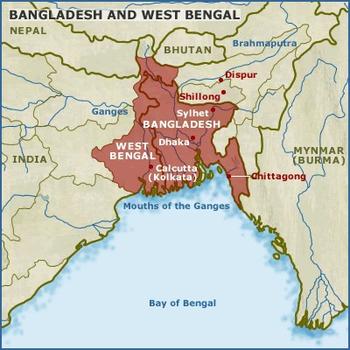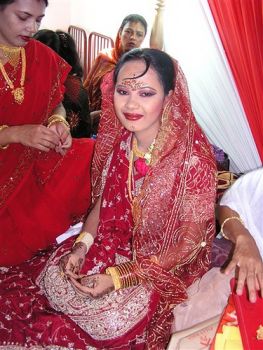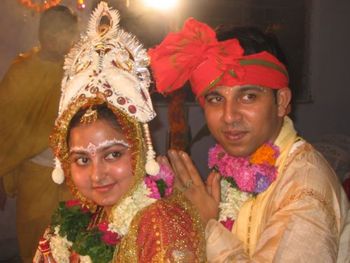Bengali Wedding
The Bengali people or Bangali as they call themselves live in the historic region of Bengal. This region of South Asia is now divided between Bangladesh and India. In India most of them live in the state of West Bengal.
 Map of Bengal
Map of Bengal
They speak the Bengali or Bangla. It is a language belonging to the eastern Indo-Aryan branch of the Indo-European languages. Large majority of the Bengali are Muslims and Hindus. Only about 1% of them are Buddhists and Christians.
The engagement ceremony starts with Adan Pradan ("give and take"). It includes the reading of ancestral lines by a family priest. It is done to avoid weddings between cousins and persons who have same gotra. Gotra is the lineage or clan which every Hindu gets at birth. In most cases a person gets gotra of his or her father.
If everything is fine the groom's family visits bride's family and they set a date of wedding. This is called Pakha-Dekha.
The ceremony following next is called Aashirwad or Patri Patra. It is held few days before the wedding in bride's or groom's home to confirm the new union between two families. The ceremony is led by purohit, meaning a priest.
Before the actual wedding ceremony numerous traditions are organized. On the wedding day or on the day before it special low wooden stools or "piris" are brought to the bride's house. Bride and groom sit on them during the wedding. Piris are decorated by a friend or cousin.
Virdhi ceremony is held on a day before wedding. All family members are present at the ceremony. A puja is offered to the ancestors of bride and groom. After that traditional sand paintings called alpana or rangoli are made. On such a painting people put "ghot" (a small copper jug) with "amra pallab" (mango leaves).
All objects offered in puja are put on a "baran dala" (silver plate). "Sri" symbol is made on it. Bhagwan Narayan is brought by the priest to the puja. People worship this idol with the "agarbattis" (incense) and "diyas" (lamps). Vridhi puja is performed by the uncle from father's side of the family. The uncle and both bride and groom must be on a liquid diet.
"Dodhi Mangal" is the ceremony organized at dawn of the wedding day. Some ten married women accompany the bride and groom to a pond. With their arrival they invite the Goddess Ganga to the wedding. The women use water from a pond to ceremonially bathe the bride and groom. After this they offer them some food. Usually the couple gets "macher laija bhaja" (fried fish), "jal dhala bhaja" (rice cooked in water), "curd" (curry) and "chiruya" (dry flattened rice).
A cousin of the groom arrives in the bride's house. He brings "Gae halud tattva" or presents for the bride. The presents include several saris (traditional female garments), make up, fish, different sweets, curd, paan (chewing Betel leaf (Piper betel) combined with the areca nut), dhaan (rice husk) and durba (grass stalks).
Incense is lit, a sound of blowing conch shells can be heard. Persons who carried everything get some sweets and presents.
"Adhibas Tattva" are the presents of the bride's family for the one of the groom. They are sari for the groom's mother, fish, sweets, curd, paan, dhaan, and durba. The presents are carried by servants on a "kasar thala" (brass plate).
"Kubi Pata" is a ceremony of worshipping Sant Kuber. Kuber or Kuvera is the Hindu god of money, wealth and success. He is the Lord of all treasures and the god's treasurer. Kuber is also known as the God of Yakshas (savage creatures). Kubi Pata is held in bride's and groom's house on the day of wedding. Family members put three metal glasses filled with dhaan, "khoi" (pulses) and crushed rice on the altar of the Sant.
Snan is the ceremony held in the late afternoon or evening of the wedding day. It is held separately for the bride and groom. Several married women put turmeric and oil on the hair and body of the bride and groom. After bathing new clothes is given to the bride and groom by their in-laws.
Next in the line of ceremonies is Sankha Porana. Bride gets sankha pola or a conch shell. The sankha pola are white and red bangles which were dipped in turmeric water. Bride wears a new sari together with the sankha pola.
"Sringar" of the bride includes all these little details which make the bride look perfect. Her hair is tied into a bun. A veil is put. The "mukut" (tiara) is attached to the veil.
 Bengali bride
Bengali bride
After her makeover a design of the mukut is drawn on her face with the "chandan" (sandalwood) paste. The bride must sit with the "gaach kouto" (a blade of grass) and "kaajal laata" (hair decoration).
The "Mandap" is the place where the wedding is organized. There is a tradition of planting two banana trees at the Mandap. The Mandap is decorated with flowers and lights. Big alpana is made with rice paste too.
The wedding ceremony starts with the welcoming of the groom and his family in the bride's house. It is done with the ceremonial ringing of bells, blowing of conch shells and ululation.
 Bengali wedding
Bengali wedding
An elder female cousin of the bride holds "baran dala" (silver plate). The plate first touches groom's forehead, then the ground and after that the forehead again. It is regarded as gesture of blessing.
The groom gets some sweets and sherbet (frozen fruit juice with some milk added). When the groom is entering the house some rosewater is sprinkled on him.
Bride's uncles carry the bride to the wedding altar on their shoulders. The purohit performs the wedding ceremony. He chants mantras. Garlands are exchanged by the bride and groom.
The next tradition is called "sampradhan". The bride is given to the groom by her maternal or paternal uncle.
After the ceremony there are many more traditions. Let's first mention the "Basar Ghar". Bride and groom arrive at bride's home. Everyone is very happy. Friends and cousins are telling jokes and reciting poems.
The next morning there is "Bashi Biye". The groom decorate the forehead of bride with vermilion. He does it by looking into a mirror. The groom and bride then go to the Mandap. There they, accompanied by a priest, worship the Sun God.
"Bidaai" ceremony is the one where the bride leaves her house and go to the house of her husband. The elders bless the couple.
"Bou Baran" is the welcoming of the couple in their new home. The women living in the house pour some water under the vehicle in which the couple arrived. The wife of groom's elder brother holds a plate with some lac dye and milk under the bride's feet. Lac dye is a red substance extracted from the crude shellac resin created by the lac insect.
The bride touches the substance and colours soles of her feet. The woman then holds bride's arm and leads the bride into the house. The elders living in the house bless the couple.
"Bou Bhat" is the ceremony during which the bride prepares her first meal in her new home. The meal is called "bahubhat". This the ceremony of acceptance in her new home. After the ceremony groom's father organizes a party.
"Phool Sajja" or Flower Decoration is a ceremony where the bride wears her brand new sari and the groom wears new "dhoti" (doti) and "kurta". Dhoti is a rectangular piece of unstitched cloth, wrapped around the waist and the legs, and knotted at the waist. Kurta is a loose shirt falling either just above or below the knees of the person wearing it. It is worn by both men and women. The one worn by women is called "kurti". The ceremony got its name because of the fact that couple's bedroom is decorated with flowers.
Finally, here one more traditions observed by the Bengali. It is called "Dira Gaman". It is held when the the couple arrives in the bride's house for the first time after the wedding. During Dira Gaman the thread tied by the purohit on the bride's wrist during the wedding ceremony is cut.